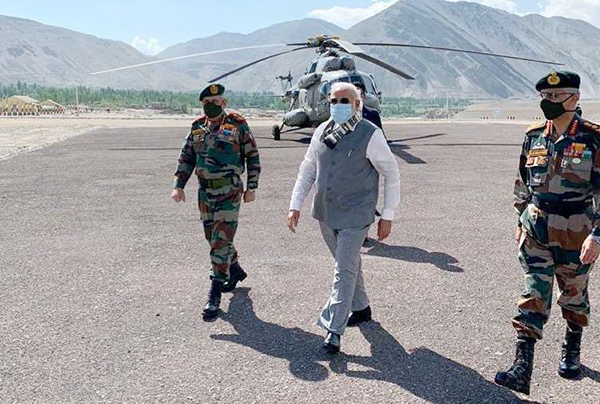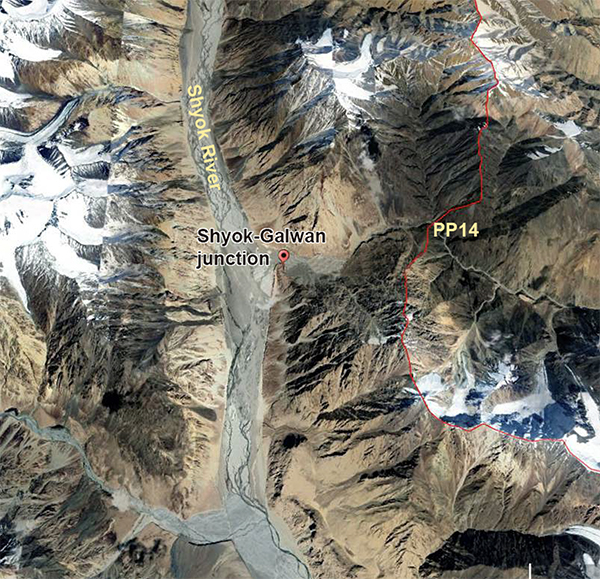
India had constructed a 255-km road from Darbuk to Shyok to Daulat Beg Oldie (DBO). It has strategic importance for logistics support and also reinforcement of DBO. A link road was being built to Patrol Point (PP) 14. To the Chinese it appeared that the 12-km link road could provide a launch pad for an offensive towards Aksai Chin using Galwan Valley. China has also built a road from Aksai Chin to this valley. Unconfirmed reports said that the Chinese had built a dam over this river to facilitate their movement or to flood the area when required.
Sometime before 15 June 2020 the Chinese attempted to come up to PP 14. In fact, they created a tented camp below it a few days earlier. This camp was forcibly removed by Indian troops on 12/13 June 2020. The Chinese did not take too kindly to it. Again they set up a new tented camp on 14 June. This was detected by Indians on 15 June 2020 and it led to a deadly scuffle.
Patrol Point 14 at the LAC had been under Indian control since 1962. A road through this area could join the Chinese road and further to the Western Highway (G219) passing through Aksai Chin. Moreover, if PP14 remains in Chinese hands, it provides a tactical overview of the Shyok river and DBO road. The Chinese had pitched tents a few hundred meters from Pp14.
On 6 June 2020, an agreement was reached between the Indian corps commander Lt Gen Harinder Singh and Maj Gen Liu Lin Commander of South Xinjiang Theatre to withdraw from present locations. India was to fall back 1.5 km westward and China by 2.5 km eastward. The disengagement was to be completed by 15 June 2020.
Before pulling out, the Indian troops wanted to ensure that the Chinese too had pulled out. Information available suggested that a patrol of 10 men under a major from 4 Mahar/ 16 Bihar was sent to ascertain the Chinese withdrawal. They found the tent and burnt it. As they were returning they were surrounded and captured by fully armed Chinese soldiers.
As soon as CO 16 Bihar, Col Santosh Babu, learnt about it, he rushed to the spot with 30 men to negotiate with the Chinese. The Chinese were on higher ground and the Indian patrol party was slowly climbing. The altitude was around 15,000 feet. The track was narrow, movement was possible only in single file — one man behind the other.
As Col Santosh‘s party was some 60-100 meters from Chinese tent, they shouted at him to come alone if he wanted to negotiate about the patrol. Col Santosh agreed and moved up with two men. He and his party was unarmed, as is the usual practice in flag meetings. After reaching they had heated exchange for 4-5 minutes but the Chinese agreed to withdraw. As soon as CO and his men turned, the Chinese attacked him with nailed clubs and all three were badly wounded.
Seeing this, the CO’s party radioed to the base and charged towards the Chinese. A hand-to-hand fight began. Indians had bayonets fixed to rifles to retaliate against Chinese nailed clubs and iron rods.
Chinese reinforcements of 400 men joined but so did 200 men from 16 Bihar and adjoining units. Thus, it became a joint operation of mixed troops also from 3 Medium Artillery Regiment, 181 Field Regiment, 4 Mahar and 3 Punjab battalions. The Ghatak platoons of other battalions joined in.
This account has been gathered from some of the servicemen who accompanied the mortal remains of the soldiers killed in action at Galwan.
In the melee a Chinese bulldozer caused a land slide and with it many PLA soldiers went hundreds of feet into the icy cold waters of the Galwan river and probably died.
Though India suffered 20 dead including Col Santosh Babu, China suffered heavier casualties. China did not give out the number of casualties. Global Times claimed that it did not give out number of casualties because it did not want to escalate sentiments.
Some Indian estimates put the Chinese casualties at 43. The estimate was based on the number of helicopter trips to collect the casualties, which India allowed. American intelligence reports suggests that there were 35 dead, possibly a few officers including colonels and majors.
Media reports said that the Indian soldiers taken captive were released on 18 June in exchange for a Chinese colonel held by India. This could not be verified since it was officially denied that any Indian soldier had gone missing or taken captive.


















